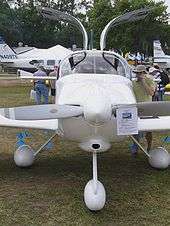Van's Aircraft RV-10
| RV-10 | |
|---|---|
 | |
| Role | homebuilt aircraft |
| Manufacturer | Van's Aircraft |
| Designer | Richard VanGrunsven |
| First flight | 29 May 2003 |
| Introduction | 2003 |
| Number built | 815 (December 2016)[1] |
| Unit cost | |
| Developed from | Van's Aircraft RV-7 |
| Variants | Van's Aircraft RV-14 |

The Van's Aircraft RV-10 is a four-seat, single-engine, low-wing homebuilt airplane sold in kit form by Van's Aircraft. It is the first four-seat airplane in the popular RV series.[3] The RV-10 first flew in May 2003, and the first kit parts were delivered to a customer in September 2003.
By December 2016, 815 RV-10s had been completed and flown.[1]
Design and development
The architect of the line of Van’s aircraft, Richard VanGrunsven, designed the RV-10 to satisfy a market demand for a four-seat version of the popular RV series aircraft. The RV-10 was designed from the start as a touring aircraft and as such it forgoes the aerobatic capabilities and the lighter handling common to the aircraft in the RV line from the RV-3 to RV-8. Instead the RV-10 design focuses on greater stability and payload.[4]
The design power is 210 to 260 hp (157 to 194 kW) and the prototype was flown with a Lycoming IO-540 powerplant of 260 hp (194 kW), which is the maximum that the airframe was designed to accept.[5] When Van's introduced the RV-10 they planned three engine configurations. One configuration using a smaller lighter 210 HP Continental IO-360ES, and two others using the larger 235 and 260HP Lycoming I/O-540. The #1 factory demonstrator used the IO-540, while the #2 RV-10 used the Continental IO-360. Vans decided to discontinue the support for the Continental engine after a poll which indicated that most builders would install the Lycoming engine,[6] although this poses problems for builders in certain countries with engine displacement limitations in which the Continental's 360 inches displacement would be admitted.[7]
This is the first aircraft in the RV line that does not have a hinged or sliding canopy. VanGrunsven instead opted for two gull-winged doors to provide access to the four seats.
This design has benefited from many of the production changes that were pioneered with the RV-7, RV-8 and the RV-9. Like those aircraft, the RV-10 uses computer assisted design to produce a kit with pre-drilled rivet holes, thus greatly reducing assembly time for the builder. The RV-10 is available only as a tricycle landing gear version and no tailwheel or retractable landing gear versions are planned.
The aircraft is constructed of aluminum with the cabin structure and gull-winged doors made from composite materials. The landing gear is tubular steel with the nosewheel mounting tube welded to the engine mount. As in all nose-wheel equipped RV aircraft, the nosewheel is free castering and the aircraft is steered with differential braking. The brakes are mounted conventionally on the rudder pedal toes.
The amount of time and effort required to build the airplane can vary greatly, but Vans claims that the average first-time builder can complete it in 2,000 hours.[5]
The total price of the standard-build kit as of December 2016, was US$46,090, which did not include an engine or avionics. A "quick-build" option was US$59,530.[2]




Variants
- Aircraft Turbine Solution Group PBS TP-100 RV-10
- The RV-10 was selected as the testbed aircraft for the Diemech TP 100 241 hp (180 kW) turboprop engine, which fist flew on 8 June 2014.[8] The testbed aircraft was outfitted with 120 gallon fuel tanks and was to be tested at altitudes of up to 20,000 ft (6,096 m).[9][10]
Specifications (RV-10)
Specifications are given for 260HP, IO-540 configuration.
General characteristics
- Crew: Pilot
- Capacity: 4 occupants (Including Pilot)
- Length: 24 ft 5 in (7.44 m)
- Wingspan: 31 ft 9 in (9.68 m)
- Height: 8 ft 8 in (2.64 m)
- Wing area: 148 ft² (13.7 m²)
- Empty weight: 1,520 lb-1660 lb (689 kg-753 kg)
- Loaded weight: 2,700 lb (1225 kg)
- Max. takeoff weight: 2600lb (1181kg)
- Landing Distance (260hp; Max Weight): 650ft
- Powerplant: 1 × Lycoming O-540/IO-540, 210-260hp (157-194 kW)
Performance
- Never exceed speed: 230 mph (370 km/h, 200 kt)
- Maximum speed: 208 mph at sea level (332 km/h, 179 kt)
- Cruise speed: 201 mph (323 km/h, 175 kt)
- Stall speed: 63 mph (101 km/h, 55 kt)
- Range: 1,000 miles Cruise 55% power at 8,000 ft (1,600 km)
- Service ceiling: 20,000 ft (est) (6,100 m)
- Rate of climb: 1,450 ft/min (7.4 m/s)
- Wing loading: 18.6 lb/ft² (91 kg/m²)
See also
- Related development
- Aircraft of comparable role, configuration and era
References
- 1 2 Vans Aircraft (10 December 2016). "First Flights". Retrieved 10 December 2016.
- 1 2 Vans Aircraft Website Cost Estimator December 2016 https://www.vansaircraft.com/public/cost-estimator.htm
- ↑ Vandermeullen, Richard: 2011 Kit Aircraft Buyer's Guide, Kitplanes, Volume 28, Number 12, December 2011, page 74. Belvoir Publications. ISSN 0891-1851
- ↑ Bayerl, Robby; Martin Berkemeier; et al: World Directory of Leisure Aviation 2011-12, page 124. WDLA UK, Lancaster UK, 2011. ISSN 1368-485X
- 1 2 Kitplanes Staff: 2008 Kit Aircraft Directory, page 78, Kitplanes Magazine December 2007 Volume 24, Number 12, Belvoir Publications, Aviation Publishing Group LLC.
- ↑ 2005 #1 Issue of the RVator
- ↑ http://www.fomento.gob.es/NR/rdonlyres/1AC8F7F7-4133-4A0D-B4D2-9E2DFF400334/111570/3161982.pdf
- ↑ "The RV-10 aircraft completed its first flight" (Press release). PBS Velká Bíteš. June 2014. Retrieved 26 August 2016.
- ↑ Bertorelli, Paul (26 March 2012). "Is There Room For A 240-HP Turbine?". AVweb. Retrieved 27 March 2012.
- ↑ "Turboprop solution". AOPA Pilot: 38. June 2014.
External links
| Wikimedia Commons has media related to Van's Aircraft RV-10. |